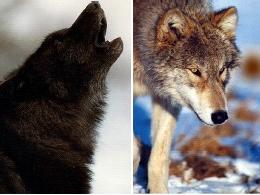The following story shows that evolution is not one-way - even a group that split from its parent group, like the dogs split from their wolf ancestors, can still influence its evolution. Thousands of years after the split, matings between dogs and wolves gave wolves a new gene.

The following story shows that evolution is not one-way - even a group that split from its parent group, like the dogs split from their wolf ancestors, can still influence its evolution. Thousands of years after the split, matings between dogs and wolves gave wolves a new gene.
So who gave wolves the color black? The question seems strange: after all, wolves are gray-white, not black. But it turns out that certain wolves in North America have completely black fur, and their prevalence in the population varies according to the lifestyle of the different groups of wolves. Such wolves are very rare among the groups that migrate in the tundra, but are much more common in the groups that live year-round in the forests.
These changes in prevalence have led researchers to assume that the black fur gives wolves an advantage in a certain area - it is possible, for example, that the black fur contributes to camouflage in the shady forests, but not in the open plains of the tundra. A diverse group of researchers from Stanford University and other universities in the USA, Canada, Italy and Sweden, led by Toby Anderson, tried to understand the genetic basis of the phenomenon - what is the gene that causes the wolves' fur to turn black.
In an article recently published in Science magazine, the researchers revealed that the gene is a gene that codes for a protein in the cell called defensin, or CBD103. The finding was quite surprising, since this protein is not known for its role in the production of pigments, but rather for its role in the immune system. But a certain mutation in this gene causes the entire fur to turn black, and not only in wolves - the same mutation also appears in their relatives, the dogs. In almost every breed in which completely black fur can appear - such as Labradors, Great Danes, and even poodles - the cause of this is the same mutation. The researchers examined the mutant gene and the areas on the chromosome that surround it, and saw that the entire DNA segment surrounding the mutant gene is very similar in dogs and wolves - and is also very similar to the segment surrounding the normal gene, which does not cause black fur, in dogs. The segment of DNA surrounding the normal gene in the wolves, however, was markedly different.
The conclusion that the researchers drew from this is that the mutant gene reached the North American wolves from the dogs, by mating with them.
The origin of dogs is from wolves - the new subspecies was created when dogs were domesticated, sometime between 15 and 40 thousand years ago, in East Asia. The researchers do not know exactly when the mutation was created - it could have been created before the dog and wolf lineages separated from each other, or after. But while the mutation is quite common among different dog breeds, it is completely absent from almost all wolf populations in the world - except for the populations in question in North America and another population in Italy. The population situation in Italy is quite bleak, and in their living areas there are many more wild dogs than wolves - and as a result there are many pairings between wolves and dogs. The evidence from Italy strengthens the assumption that the mutation reached the wolves exclusively through mating with dogs - that is, the original mutation occurred only in the dogs, after the split between the two species, or alternatively, the mutation occurred before the split but completely disappeared from the branch that led to the wolves, and remained only in the dogs.
In contrast to Italy, where the mutation apparently reached the wolf population only recently - due to their dwindling numbers - the North American wolves acquired the mutation many generations ago, and it spread to different populations on the continent. It is not clear whether the dogs that passed on the mutation were the dogs of the first settlers in America, a few thousand years ago, or of the Spaniards who arrived there only a few hundred years ago.
In this case, a mutation that probably originated in the dogs found its way to their wild ancestors. Therefore, it is possible that when humans develop certain traits in domesticated animals (as they have been doing for at least 12,000 years), some of these traits may also spread to wild populations of that animal, affecting them in unexpected ways.
